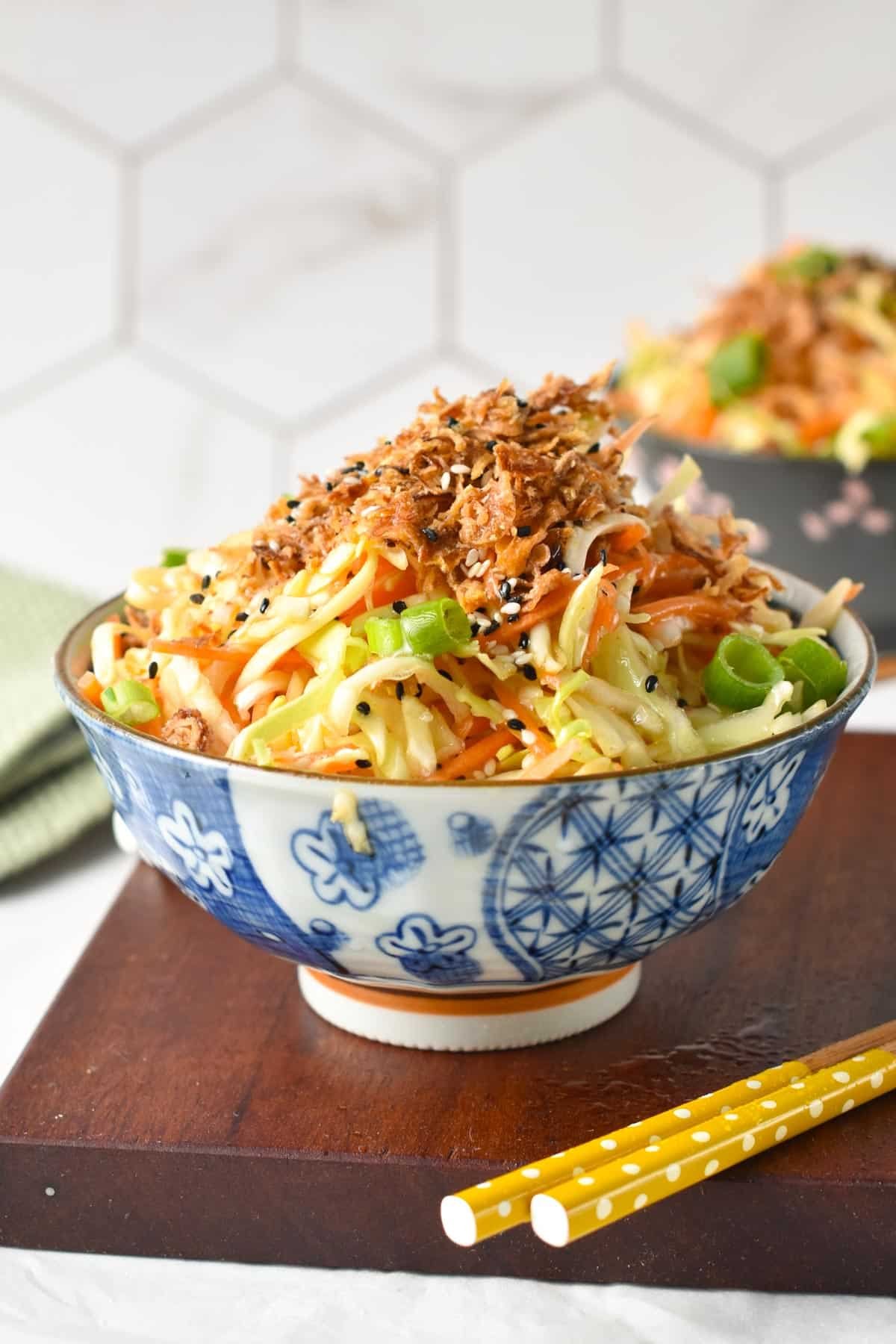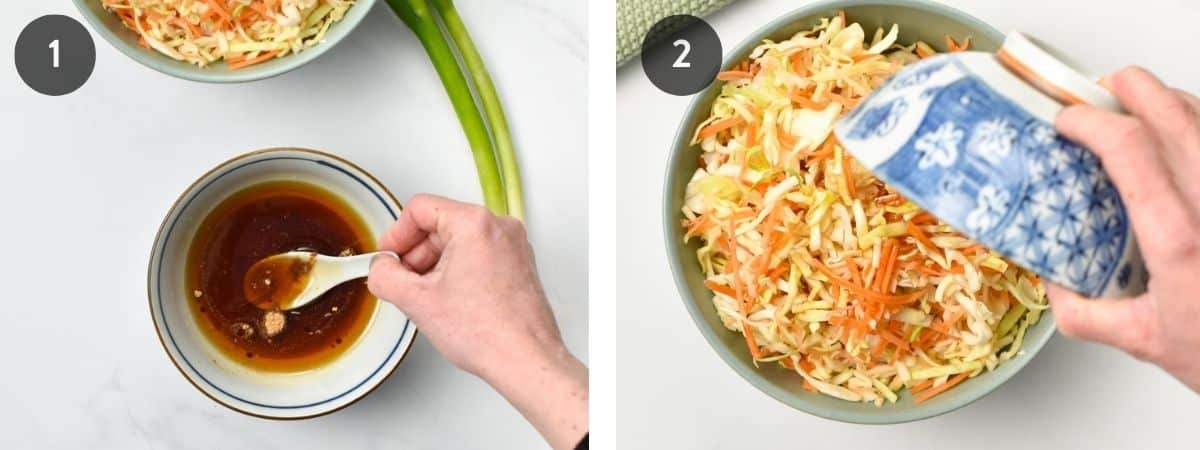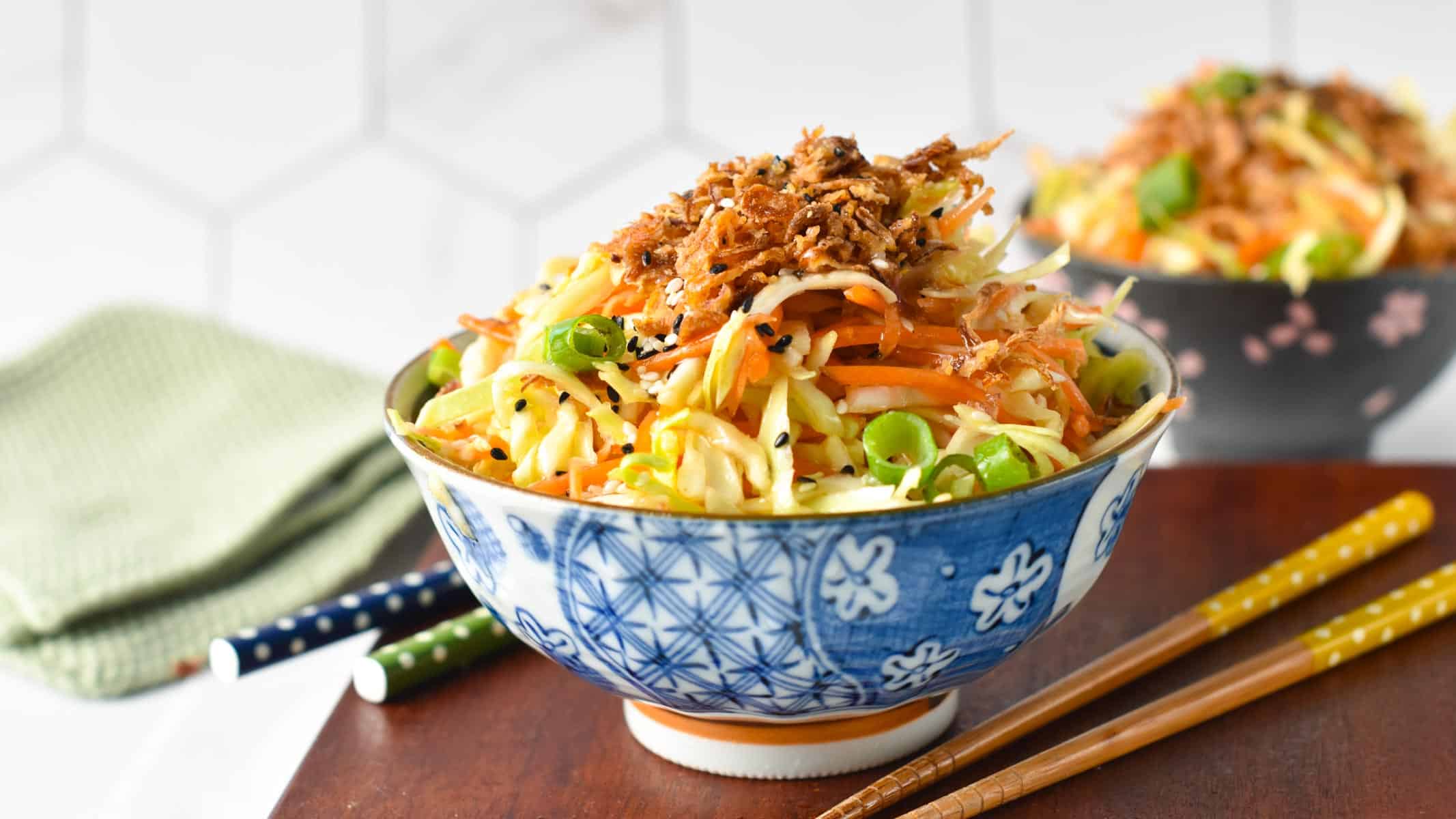Japanese Cabbage Salad
This recipe may contain Amazon or other affiliate links. As an Amazon Associate I earn from qualifying purchases.
This Japanese Cabbage Salad is an easy 5-minute Japanese side dish with crunchy shredded cabbage in a delicious Japanese dressing.

One side dish I always order at my favorite Japanese restaurant is a Japanese coleslaw along with my Japanese Crepes and Sautéed Eggplant. Japanese cabbage salad is light, healthy, packed with a lot of fiber, and cabbage is also a low-carb vegetable.
This cabbage Japanese salad is the perfect cold side to any warm Japanese fried food like chicken, cooked fish, or pork katsu.
A Japanese cabbage salad is a typical Japanese side dish served next to a warm Japanese protein dish like Tonkatsu chicken or grilled fish. It’s a crunchy cabbage salad called Japanese coleslaw made from very thinly-shredded cabbage. It’s served with a light dressing made of sesame and soy flavors.
Ingredients and Substitutions
- Shredded Cabbage – This restaurant-style Japanese salad is made with thinly sliced cabbage or coleslaw, a mix of green cabbage and carrots. To prepare this salad in less than 10 minutes, use packaged shredded coleslaw. It saves time, and if you discard the pre-made sauce provided in the packet, the vegetable is as healthy as if you slice them at home.
- Rice Vinegar – or wine vinegar.
- Soy Sauce or tamari sauce for a gluten-free option.
- Toasted Sesame Oil – Sesame oil brings a delicious flavor to the salad.
- Garlic – Fresh crushed garlic or powdered garlic.
- Ginger – Fresh ginger is best, but you can use powdered ginger.
- Honey – Most recipes use white sugar. I love honey as a healthier alternative, and the flavor is fantastic with soy sauce. You can also use maple syrup.
- Green Onion – to serve
- Sesame Seeds – To serve the salad I use a combo of white sesame seeds and black sesame seeds.
- Fried Shallots – Or fried onions.
- Japanese Mayonnaise – optional
How To Make Japanese Cabbage Salad
I am not Japanese, so this Japanese cabbage salad is purely inspired by my favorite salad from a local Japanese restaurant.
I bought pre-shredded cabbage for this recipe. If you want to shred cabbage, you can use a food processor with a large shredding attachment or a hand grater. Feel free to use only green cabbage, or a combination of green and red cabbage.
- First, cut the cabbage in half, remove the hard part of the cabbage feet, and shred it into a thin texture. Peel and shred the carrot.

- In a mixing bowl, add all the salad dressing ingredients, and whisk to combine evenly. You can also place all the dressing ingredients in a glass mason jar, close, and shake.
- In a large bowl, add the shredded slaw, pour the dressing on top, and toss to coat evenly.
- Taste and adjust the recipe adding more salt, pepper, or a drizzle extra soy sauce to boost savory umami flavors.
Serving Suggestions
Then, serve the salad with some of the toppings below.
- Spring onions
- Sesame seeds
- Drizzle of Japanese mayonnaise
- Sriracha sauce for a touch of spice
- Fried shallots – This is not a classic Japanese topping but adds a delicious crunch and flavor to the salad. For a more authentic approach, try adding bonito flakes.
Storage Instructions
You can store the Japanese salad leftovers in an airtight container in the fridge for up to 2 days. After that time, the cabbage softens, and the texture is not as crunchy and tasty.

Variations
You can use this salad recipe to make different kinds of Asian cabbage salad by adding some ingredients. For example, you can add in the shredded cabbage, some of the below vegetables:
- Finely sliced red bell pepper
- Bean sprouts
- Roasted peanuts
- Fresh ginger
- Fresh mint or coriander
Allergy Swaps
Below are some ingredients substitution ideas if you need them.
- Gluten-Free – Swap soy sauce for tamari sauce.
- Sugar-Free – Swap the honey for a sugar-free sweetener of choice or leave out any sweetener.
- Seed-Free – Skip the sesame seed and use slivered almonds or sliced almonds. Use peanut oil or light olive oil.
- Carrot-Free – Use only shredded cabbage or swap carrot with shredded radish.
- Rice Vinegar – You can use apple cider vinegar, lemon juice, or white vinegar for this recipe.
Frequently Asked Questions
Below are my answers to your most common questions about this easy salad recipe.
To make a super thin, fluffy cabbage salad like in a Japanese restaurant, you need a thin progressive mandolin.
Remove the tough core part of the cabbage, then select the inside part of the cabbage where the leaves are packed, white, not green. Hold from the top of the head and shred until thin and fluffy.
For a warm cooked recipe, Japanese cuisine uses Nappa cabbage. However, for salad and slaw, use green cabbage or green and red cabbage.
More Salad Recipes
Below are some more salad recipe ideas for you to try.
Did You Like This Recipe?
Leave a comment below or head to our Facebook page for tips, our Instagram page for inspiration, our Pinterest for saving recipes, and Flipboard to get all the new ones!

Japanese Cabbage Salad
Ingredients
- 5 cups Shredded Coleslaw Mix or ultra thin shredded green cabbage
Dressing
- 3 tablespoons Sesame Oil
- 3 tablespoons Rice Vinegar
- 1 tablespoon Honey or sugar
- 1 large Garlic peeled, crushed
- ¼ teaspoon Ground Ginger
- 2 teaspoons Soy Sauce
To serve – optional
- 1 teaspoon Sesame Seeds
- 1 tablespoon Green Onion finely diced
- 1 tablespoon Japanese Mayonnaise drizzle
- ¼ cup Fried Shallots
Instructions
- In a large mixing bowl, add the shredded coleslaw. Set aside.
- In another bowl, whisk all the dressing ingredients, pour over the shredded cabbage, and toss to coat.
- Serve with fried shallots, sliced green onions, sesame seeds, and a drizzle of Japanese mayonnaise.
Nutrition
Disclaimer
The recipes, instructions, and articles on this website should not be taken or used as medical advice. The nutritional data provided on Sweetashoney is to be used as indicative only. The nutrition data is calculated using WP Recipe Maker. Net Carbs is calculated by removing the fiber and some sweeteners from the total Carbohydrates.
You should always calculate the nutritional data yourself instead of relying on Sweetashoney's data. Sweetashoney and its recipes and articles are not intended to cure, prevent, diagnose, or treat any disease. Sweetashoney cannot be liable for adverse reactions or any other outcome resulting from the use of recipes or advice found on the Website.







Share this post!
If you enjoyed this post, share it with your close ones!
Leave a comment